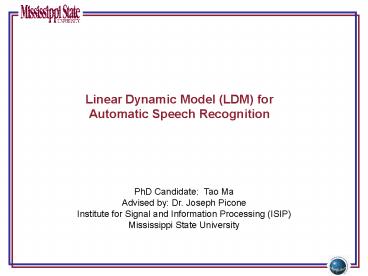Linear Dynamic Model LDM for Automatic Speech Recognition PowerPoint PPT Presentation
1 / 18
Title: Linear Dynamic Model LDM for Automatic Speech Recognition
1
Linear Dynamic Model (LDM) for Automatic Speech
Recognition
PhD Candidate Tao Ma Advised by Dr. Joseph
Picone Institute for Signal and Information
Processing (ISIP) Mississippi State University
2
- An Example of Kalman Filter (another name of LDM)
- In control system engineering, Kalman Filter
succeeds to model a system with noisy observations
Filtering Position at present time (remove
noise effect) Predicting Position at a future
time Smoothing Position at a time in the past
Observation
A Kalman Filter models the position evolution
3
- Outline
- Why Linear Dynamic Model (LDM)?
- Linear Dynamic Model
- Pilot experiment LDM phone classification on
Aurora 4 - Hybrid HMM/LDM decoder architecture for LVCSR
- Future work
4
- HMM Speech Recognition System
Hidden Markov Models
5
- Is HMM a perfect model for ASR?
- Progress on improving the accuracy of HMM-based
system has slowed in the past decade - Theory drawbacks of HMM
- False assumption that frames are independent and
stationary - Spatial correlation is ignored (diagonal
covariance matrix) - Limited discrete state space
Accuracy
Clean
Noisy
Time
6
- Motivation of Linear Dynamic Model (LDM) Research
- Motivation
- A model which reflects the characteristics of
speech signals will ultimately lead to great ASR
performance improvement - LDM incorporates frame correlation information of
speech signals, which is potential to increase
recognition accuracy - Filter characteristic of LDM has potential to
improve noise robustness of speech recognition - Fast growing computation capacity (thanks to
Intel) make it realistic to build a two-way
HMM/LDM hybrid speech engine
7
- State Space Model
- Linear Dynamic Model (LDM) is derived from State
Space Model - Equations of State Space Model
y observation feature vector x corresponding
internal state vector h() relationship function
between y and x at current time f() relationship
function between current state and all previous
states epsilon noise component eta noise
component
8
- Linear Dynamic Model
- Equations of Linear Dynamic Model (LDM)
- Current state is only determined by previous
state - H, F are linear transform matrices
- Epsilon and Eta are driving components
y observation feature vector x corresponding
internal state vector H linear transform matrix
between y and x F linear transform matrix
between current state and previous state epsilon
driving component eta driving component
9
- Kalman filtering for state inference (E-Step of
EM training)
For a speech sound,
Human Being Sound System
e
Kalman Filtering Estimation
10
- RTS smoother for better inference
- Rauch-Tung-Striebel (RTS) smoother
- Additional backward pass to minimize inference
error - During EM training, computes the expectations of
state statistics
Standard Kalman Filter
Kalman Filter with RTS smoother
11
- Maximum Likelihood Parameter Estimation (M-Step
of EM training)
LDM Parameters
aa ae ah ao aw ay b ch d dh eh er
Nothing but matrix multiplication!
12
- LDM for Speech Classification
x
aa
y
x
x
ch
MFCC Feature
Hypothesis
x
eh
HMM-Based Recognition
x
LDM-Based Recognition
aa
y
x
MFCC Feature
x
ch
Hypothesis
x
eh
13
- Challenges of Applying LDM to ASR
- Segment-based model
- frame-to-phoneme information is needed before
classification - EM training is sensitive to state initialization
- Each phoneme is modeled by a LDM, EM training is
to find a set of parameters for a specific LDM - No good mechanism for state initialization yet
- More parameters than HMM (23x)
- Currently mono-phone model, to build a tri-phone
model for LVCSR would need more training data
14
- Pilot experiment phone classification on Aurora 4
- Aurora 4 Wall Street Journal six kinds of
noises - Airport, Babble, Car, Restaurant, Street, and
Train - Frame-to-phone alignment is generated by ISIP
decoder (force align mode) - Adding language model will get 93 accuracy for
clean data - 40 phones, one vs. all classifier
15
- Hybrid HMM/LDM decoder architecture for LVCSR
Confidence Measurement
Best Hypothesis
16
- Status and future work
- The development of HMM/LDM hybrid decoder is
still in progress - HMM/LDM hybrid decoder is Expected to be done in
2009 - ISIP HMM/SVM hybrid decoder acts as the reference
for implementation - Future work
- Research has proved the nonlinear effects in
speech signals - Investigate the probability of replacing Kalman
filtering with nonlinear filtering (such as
Unscented Kalman Filter, Extended Kalman Filter)
17
- Thank you!
Questions?
18
- References
- Digalakis, V., Segment-based Stochastic Models
of Spectral Dynamics for Continuous Speech
Recognition, Ph.D. Dissertation, Boston
University, Boston, Massachusetts, USA, 1992. - Digalakis, V., Rohlicek, J. and Ostendorf, M.,
ML Estimation of a Stochastic Linear System with
the EM Algorithm and Its Application to Speech
Recognition, IEEE Transactions on Speech and
Audio Processing, vol. 1, no. 4, pp. 431442,
October 1993. - Frankel, J., Linear Dynamic Models for Automatic
Speech Recognition, Ph.D. Dissertation, The
Centre for Speech Technology Research, University
of Edinburgh, Edinburgh, UK, 2003.

